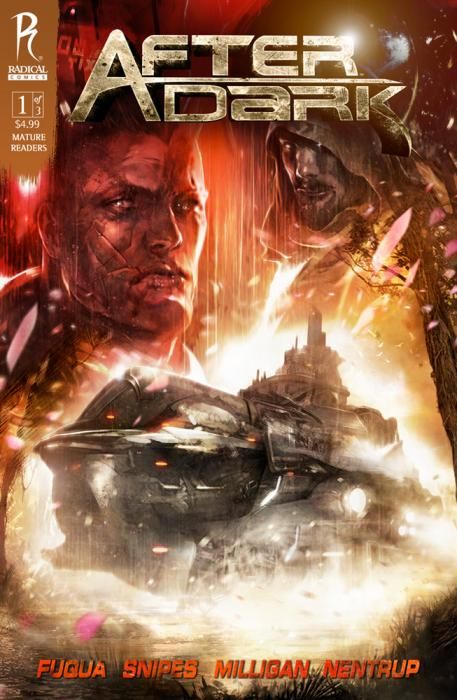This may seem odd, but the biggest surprise in reading this comic created by "Training Day" director Antoine Fuqua and actor Wesley Snipes comes from the lack of a character that is obviously Snipes in disguise. When it comes to comics created by an actor, there's usually a character that is drawn in the actor's likeness and is obviously the role he would be playing if this got made as a movie. "After Dark" #1 doesn't have the Snipes stand-in, thankfully, but that doesn't stop it from reading somewhat like a movie pitch instead of a proper comic. The plot is a standard quest with the ensemble group that doesn't quite get along. Even the dark edges Peter Milligan puts on the dialogue at certain points can't raise the issue above mediocrity.
Set at a point in the future after all of the global disasters that have been thought likely have all happened, the military of Solar City need to find a woman named Angel because of the hope she inspires in people, relying on a criminal Bedouin and the team he assembles. As far as an idea goes, this is one that's been done many times before with the post-apocalyptic quest undergone by a group of people that don't exactly get along. That's the most boring and mundane part of "After Dark," but it's also the most vague because there's no concrete reason given for why this Angel woman is important. We don't know anything about her or why she matters except people fall in love with her or feel drawn to her.
Around the edges of this plot, Milligan writes some interesting dialogue. The man in charge on the mission, Lieutenant Brood, is a man forced to take medication for some reason and speaks in vague, dark poetics. He has a nasty scar on his face and the issue begins with him narrating the deaths of others, speaking of spring (which no longer happens), and being very creepy. With the rest of the characters, Milligan has them be nasty to one another for no apparent reason than this world is harsh and nasty. While we don't get much character development, how they talk to one another provides a window into the world.
I'm torn on Jeff Nentrup's art. Done in a painted style, it's very inconsistent in its look. When depicting the dark, hostile landscapes of the future, his art is messy and alluring. Brood in the shadows is creepy and effective. It's when he shifts to characters in the light that his art becomes shiny and looks like bad 3D animation, or maybe the painted coloring used on the card of the Marvel Overpower game. They're flat and unattractive, burying his pencils beneath them and leaving half of the book looking ugly and dull. When Netrup draws the darker side of things, his line work is sketchier, his colors a lot less smooth, and the overall effect is far more interesting and attractive.
"After Dark" #1 does somewhat feel like a movie pitch with its cliche plot and ensemble cast, but Peter Milligan throws in some nice, dark touches that make it worth giving a look if a 50-page comic about a post-apocalyptic world appeals to you. With Leonardo Manco scheduled to do the art for the second issue, things should be more consistent on that end in two months.

